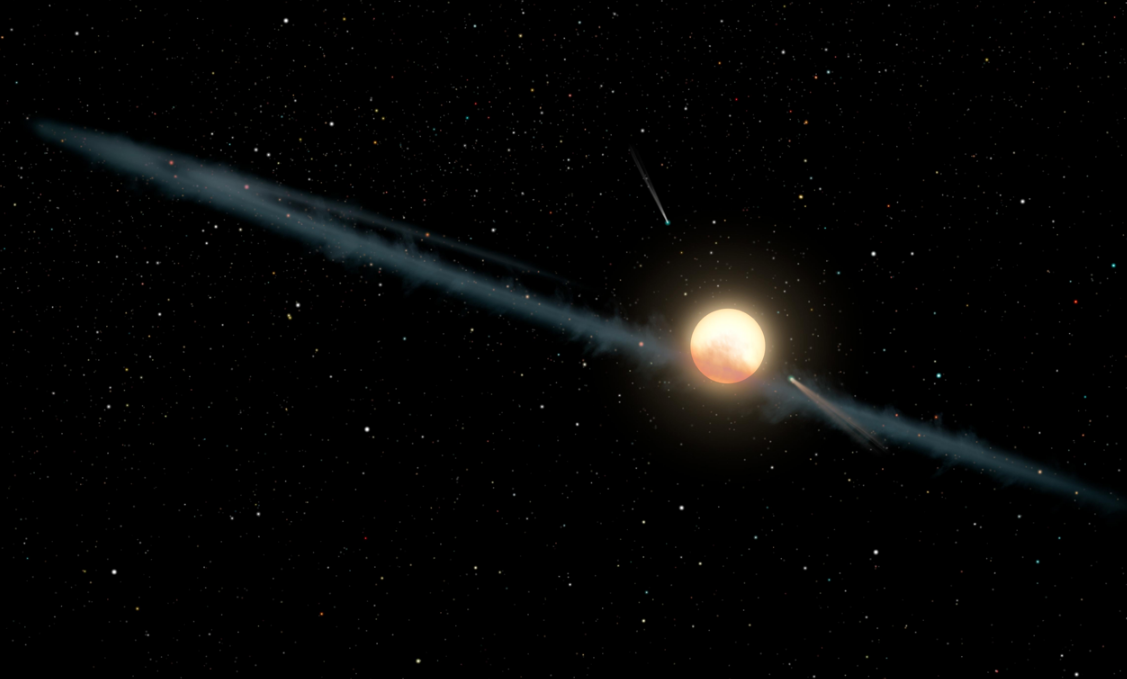KIC 8462852 (also Tabby's Star or Boyajian's Star) is an F-type main-sequence star located in the constellation Cygnus approximately 1,470 light-years (450 pc) from Earth. Unusual light fluctuations of the star, including up to a 22% dimming in brightness, were discovered by citizen scientists as part of the Planet Hunters project. In September 2015, astronomers and citizen scientists associated with the project posted a preprint of an article describing the data and possible interpretations. The discovery was made from data collected by the Kepler space telescope, which observes changes in the brightness of distant stars to detect exoplanets. Several hypotheses have been proposed to explain the star's large irregular changes in brightness as measured by its light curve, but none to date fully explain all aspects of the curve. One explanation is that an "uneven ring of dust" orbits KIC 8462852. In another explanation, the star's luminosity is modulated by changes in the efficiency of heat transport to its photosphere, so no external obscuration is required. A third hypothesis, based on a lack of observed infrared light, posits a swarm of cold, dusty comet fragments in a highly eccentric orbit, however, the notion that disturbed comets from such a cloud could exist in high enough numbers to obscure 22% of the star's observed luminosity has been doubted. Another hypothesis is that a large number of small masses in "tight formation" are orbiting the star. Furthermore, spectroscopic study of the system has found no evidence for coalescing material or hot close-in dust or circumstellar matter from an evaporating or exploding planet within a few astronomical units of the mature central star. It has also been hypothesized that the changes in brightness could be signs of activity associated with intelligent extraterrestrial life constructing a Dyson swarm. The scientists involved are very skeptical, however, with others describing it as implausible. KIC 8462852 is not the only star that has large irregular dimmings, but all other such stars are young stellar objects called YSO dippers, which have different dimming patterns. An example of such an object is EPIC 204278916. New light fluctuation events of KIC 8462852 began in the middle of May 2017. Except for a period between late-December 2017 and mid-February 2018 when the star was obscured by the Sun, the fluctuations have continued (As of July 2018).
- extraterrestrial life
- circumstellar matter
- exoplanets
1. Nomenclature
KIC is an acronym for the Kepler Input Catalog, 8462852 being the star's catalog number. Colloquially the names "Tabby's Star" and "Boyajian's Star" refer to the initial study's lead author, Tabetha S. Boyajian;[1][2] KIC 8462852 is sometimes called the "WTF Star", after the study's subtitle "Where's The Flux?"[3][4][5][6] (a joking reference to the colloquial expression of disbelief "WTF").[7]
2. Location
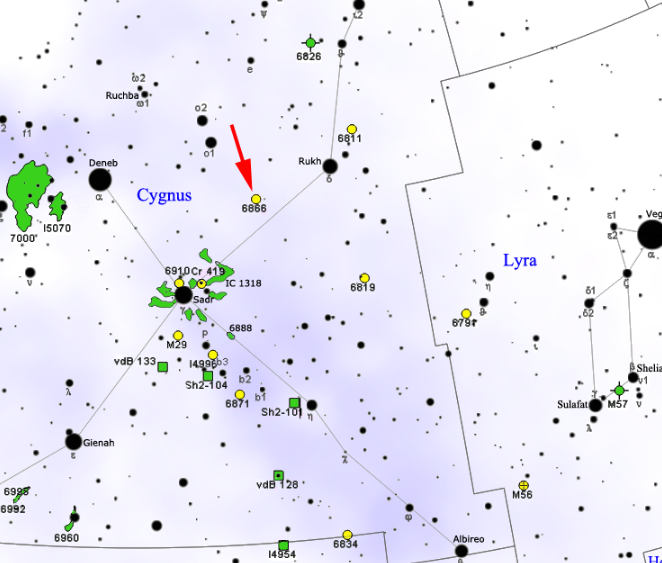
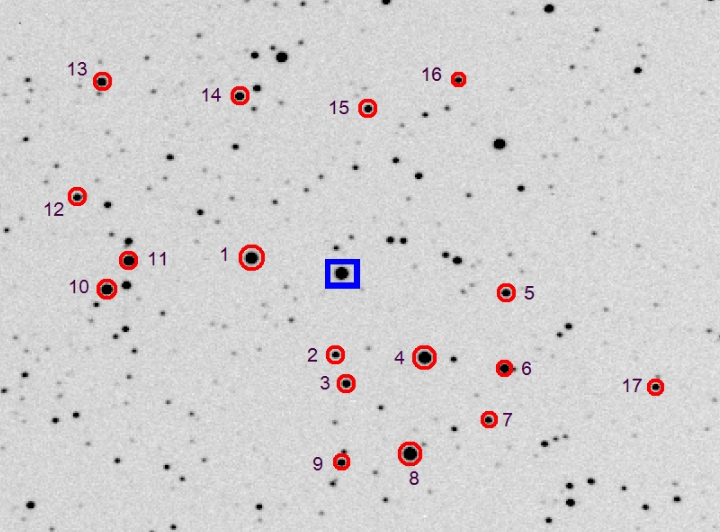
KIC 8462852 in the constellation Cygnus is located roughly halfway between the bright stars Deneb and Delta Cygni as part of the Northern Cross.[9][10] KIC 8462852 is situated south of 31 Cygni, and northeast of the star cluster NGC 6866.[10] While only a few arcminutes away from the cluster, it is unrelated and closer to the Sun than it is to the star cluster.
With an apparent magnitude of 11.7, the star cannot be seen by the naked eye, but is visible with a 5-inch (130 mm) telescope[11] in a dark sky with little light pollution.
3. History of Observations
KIC 8462852 was observed as early as the year 1890.[12][13][14] The star was cataloged in the Tycho, 2MASS, UCAC4, and WISE astronomical catalogs[15] (published in 1997, 2003, 2009, and 2012, respectively).[16][17][18][19]
The main source of information about the luminosity fluctuations of KIC 8462852 is the Kepler space observatory. During its primary and extended mission from 2009 to 2013 it continuously monitored the light curves of over 100,000 stars in a patch of sky in the constellations Cygnus and Lyra.[20]
4. Luminosity
Observations of the luminosity of the star by the Kepler space telescope show small, frequent, non-periodic dips in brightness, along with two large recorded dips in brightness roughly 750 days apart. The amplitude of the changes in the star's brightness, and the aperiodicity of the changes, mean that this star is of particular interest for astronomers.[21] The star's changes in brightness are consistent with many small masses orbiting the star in "tight formation".[22]
The first major dip, on 5 March 2011, reduced the star's brightness by up to 15%, and the next 726 days later (on 28 February 2013) by up to 22%. (A third dimming, around 8%, occurred 48 days later.) In comparison, a planet the size of Jupiter would only obscure a star of this size by 1%, indicating that whatever is blocking light during the star's major dips is not a planet, but rather something covering up to half the width of the star.[21] Due to the failure of two of Kepler's reaction wheels, the star's predicted 750-day dip around February 2015 was not recorded.[23][24] The light dips do not exhibit an obvious pattern.[25]
In addition to the day-long dimmings, a study of a century's worth of photographic plates suggests that the star has gradually faded from 1890 to 1989 by about 20%, which would be unprecedented for any F-type main-sequence star.[12][13] Teasing accurate magnitudes from long-term photographic archives is a complex procedure, however, requiring adjustment for equipment changes, and is strongly dependent on the choice of comparison stars. Another study, examining the same photographic plates, concluded that the possible century-long dimming was likely a data artifact, and not a real astrophysical event.[14] Another study from plates between 1895 and 1995 found strong evidence that the star has not dimmed, but kept a constant flux within a few percent, except a 8% dip on 24 October 1978, resulting in a period of the putative occulter of 738 days.[26]
A third study, using light measurements by the Kepler observatory over a four-year period, determined that KIC 8462852 dimmed at about 0.34% per year before dimming more rapidly by about 2.5% in 200 days. It then returned to its previous slow fade rate. The same technique was used to study 193 stars in its vicinity and 355 stars similar in size and composition to KIC 8462852. None of these stars exhibited such dimming.[27]
In 2018, a possible 1,574-day (4.31-year) periodicity in dimming of the star was reported.[28]
5. Hypotheses
Originally it was erroneously thought that, based on KIC 8462852's spectrum and stellar type, its changes in brightness could not be attributed to intrinsic variability.[23] Consequently, a few hypotheses have been proposed involving material orbiting the star and blocking its light, although none of these fully fit the observed data.[29]
Some of the proposed explanations involve interstellar dust, a series of giant planets with very large ring structures,[30][31] a recently captured asteroid field,[23] the system undergoing Late Heavy Bombardment,[32][33] and an artificial megastructure orbiting the star.[34]
As of 2018, the leading hypothesis suggests that the "missing" heat flux involved in the star's dimming can be stored within the star's interior. Such variations in luminosity might arise from a number of mechanisms affecting the efficiency of heat transport inside the star.[35][36]
5.1. Circumstellar Dust Ring
The smoking gun: Researchers found less dimming in the infrared light from the star than in its ultraviolet light. Any object larger than dust particles would dim all wavelengths of light equally when passing in front of Tabby's Star.
Meng et al. (2017) suggested that, based on observational data of KIC 8462852 from the Swift Gamma-Ray Burst Mission, Spitzer Space Telescope and Belgian AstroLAB IRIS Observatory, only "microscopic fine-dust screens", originating from "circumstellar material", are able to disperse the starlight in the way detected in their measurements.[37][38][39][40] Based on these studies, on 4 October 2017, NASA reported that the unusual dimming events of KIC 8462852 are due to an "uneven ring of dust" orbiting the star.[37] Although the explanation of a significant amount of small particles orbiting the star regards "long-term fading" as noted by Meng,[38] the explanation also seems consistent with the week-long fadings found by amateur astronomer Bruce L. Gary and the Tabby Team, coordinated by astronomer Tabetha S. Boyajian, in more recent dimming events.[41][42][43][44] A related, but more sophisticated, explanation of dimming events, involving a transiting "brown dwarf" in a 1600-day eccentric orbit near KIC 8462852, a "drop feature" in dimness and predicted intervals of "brightening", has been proposed.[45][46][47][48] Dimming and brightening events of KIC 8462852 continue to be monitored; related light curves are currently updated and released frequently.[49][50]
Nonetheless, data similar to that observed for KIC 8462852, along with supporting data from the Chandra X-ray Observatory, were found with dust debris orbiting WD 1145+017, a white dwarf that also has unusual light curve fluctuations.[51] Further, the highly variable star RZ Piscium, which brightens and dims erratically, has been found to emit excessive infrared radiation, suggesting that the star is surrounded by large amounts of gas and dust, possibly resulting from the destruction of local planets.[52][53]
5.2. A Cloud of Disintegrating Comets
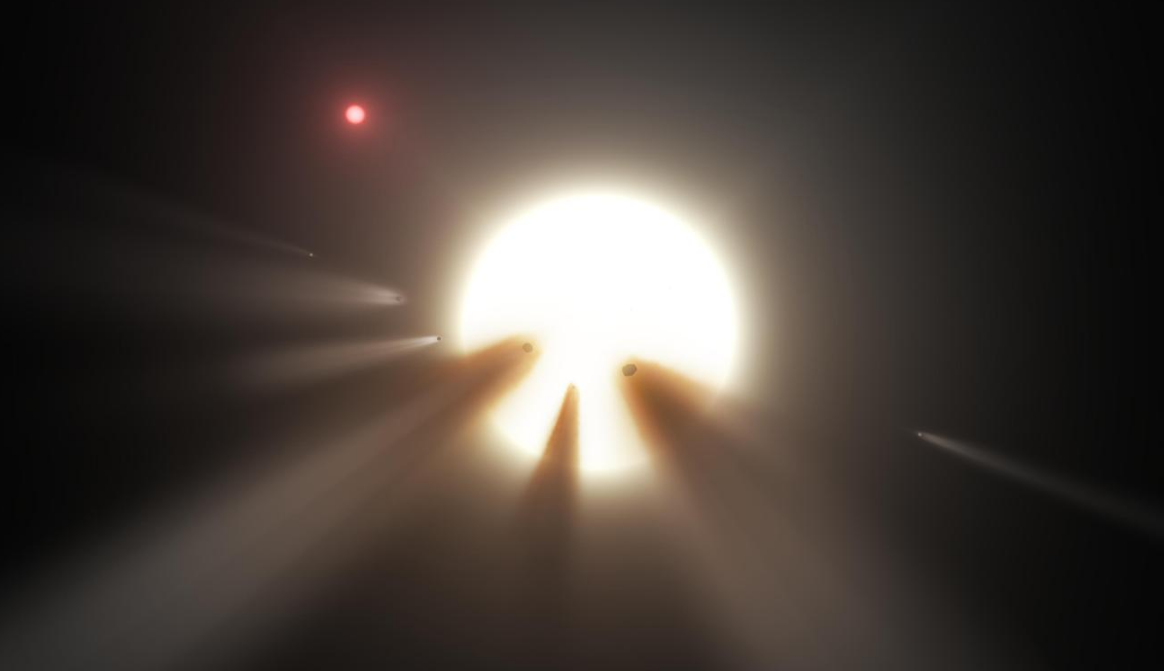
One proposed explanation for the reduction in light is that it is due to a cloud of disintegrating comets orbiting the star elliptically.[23][32][54][55] This scenario would assume that KIC 8462852's planetary system has something similar to the Oort cloud and that gravity from a nearby star caused comets from said cloud to fall closer into the system, thereby obstructing KIC 8462852's spectra. Evidence supporting this hypothesis includes an M-type red dwarf within 132 billion kilometers (885 astronomical unit|AU) of KIC 8462852.[23] The notion that disturbed comets from such a cloud could exist in high enough numbers to obscure 22% of the star's observed luminosity has been doubted.[21]
Submillimetre-wavelength observations searching for farther-out cold dust in an asteroid belt akin to the Sun's Kuiper Belt suggest that a distant "catastrophic" planetary disruption explanation is unlikely; the possibility of a disrupted asteroid belt scattering comets into the inner system is still to be determined.[56]
5.3. Younger Star with Coalescing Material Around It
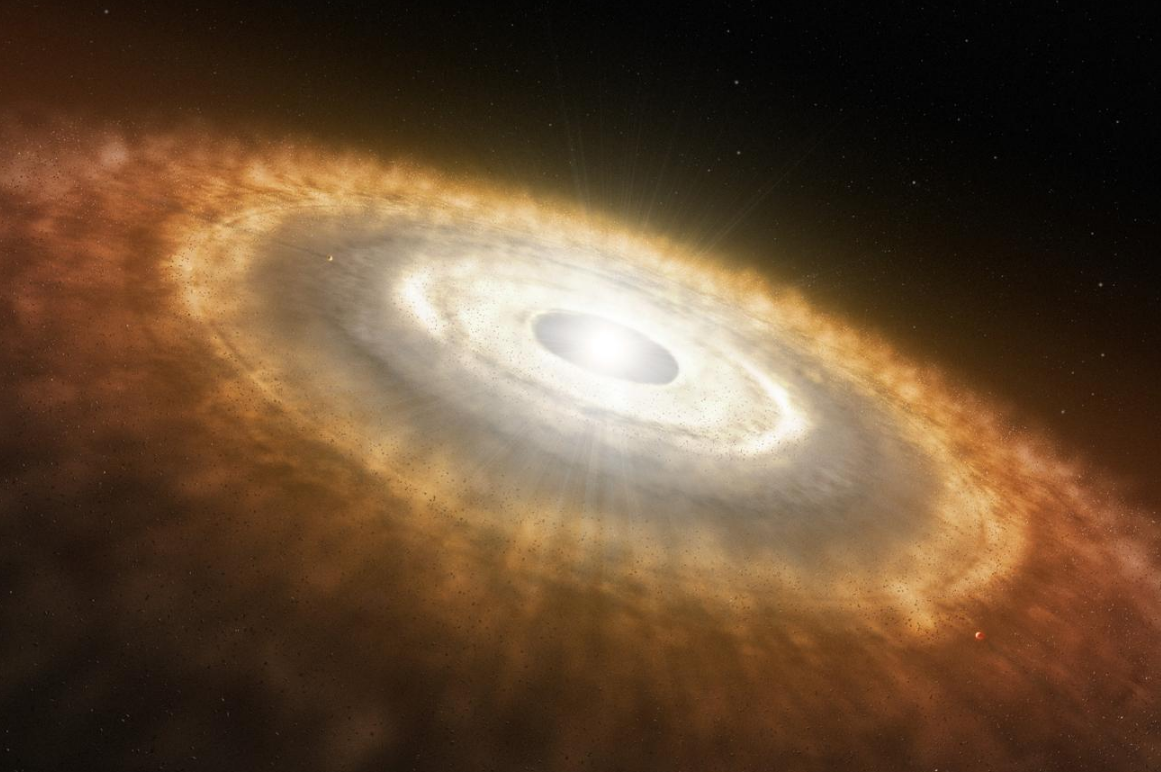
Astronomer Jason T. Wright and others who have studied KIC 8462852 have suggested that if the star is younger than its position and speed would suggest, then it may still have coalescing material around it.[3][6][57]
A 0.8–4.2-micrometer spectroscopic study of the system using the NASA Infrared Telescope Facility (NASA IRTF) found no evidence for coalescing material within a few astronomical units of the mature central star.[32][33]
5.4. Planetary Debris Field
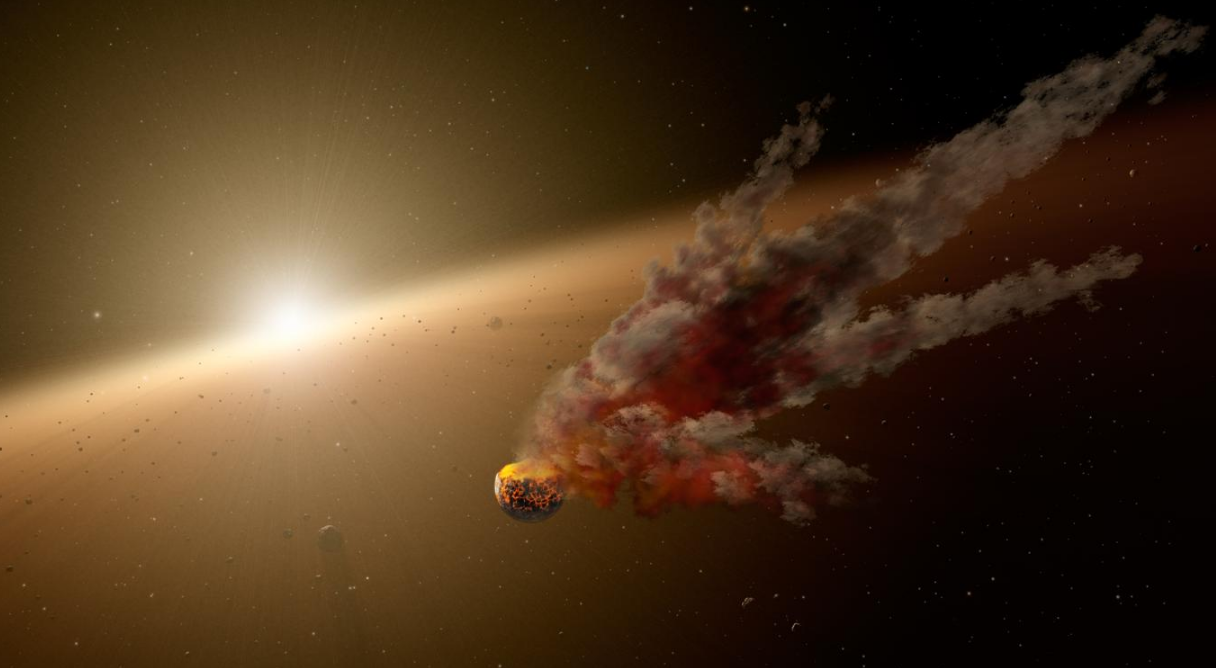
High-resolution spectroscopy and imaging observations have also been made, as well as spectral energy distribution analyses using the Nordic Optical Telescope in Spain.[23][30] A massive collision scenario would create warm dust that glows in infrared wavelengths, but there is no observed excess infrared energy, ruling out massive planetary collision debris.[21] Other researchers think the planetary debris field explanation is unlikely, given the very low probability that Kepler would ever witness such an event due to the rarity of collisions of such size.[23]
As with the possibility of coalescing material around the star, spectroscopic studies using the NASA IRTF found no evidence for hot close-in dust or circumstellar matter from an evaporating or exploding planet within a few astronomical units of the central star.[32][33] Similarly, a study of past infrared data from NASA's Spitzer Space Telescope and Wide-field Infrared Survey Explorer found no evidence for an excess of infrared emission from the star, which would have been an indicator of warm dust grains that could have come from catastrophic collisions of meteors or planets in the system. This absence of emission supports the hypothesis that a swarm of cold comets on an unusually eccentric orbit could be responsible for the star's unique light curve, but more studies are needed.[32][58]
5.5. Consumption of a Planet
In December 2016, a team of researchers proposed that KIC 8462852 swallowed a planet, causing a temporary and unobserved increase in brightness due to the release of gravitational energy. As the planet fell into its star, it could have been ripped apart or had its moons stripped away, leaving clouds of debris orbiting the star in eccentric orbits. Planetary debris still in orbit around the star would then explain its observed drops in intensity.[59] Additionally, the researchers suggest that the consumed planet could have caused the star to increase in brightness up to 10,000 years ago, and its stellar flux is now returning to the normal state.[59][60]
5.6. Large Planet with Oscillating Rings
Sucerquia et al. (2017) suggested that a large planet with oscillating rings may help explain the unusual dimmings associated with KIC 8462852.[61][62]
5.7. Large Ringed Planet Followed by Trojan Swarms
Ballesteros et al. (2017) proposed a large, ringed planet trailed by a swarm of Trojan asteroids in its L5 Lagrangian point, and estimated an orbit that predicts another event in early 2021 due to the leading Trojans followed by another transit of the hypothetical planet in 2023.[63] The model suggests a planet with a radius of 4.7 Jupiter radii, large for a planet (unless very young). An early red dwarf of about 0.5 R☉ would be easily seen in infrared. The current radial velocity observations available (four runs at σv ≈ 400 m/s) hardly constrain the model, but new radial velocity measurements would greatly reduce the uncertainty. The model predicts a discrete and short-lived event for the May 2017 dimming episode, corresponding to the secondary eclipse of the planet passing behind KIC 8246852, with about a 3% decrease in the stellar flux with a transit time of about 2 days. If this is the cause of the May 2017 event, the planet's orbital period is more precisely estimated as 12.41 years with a semi-major axis of 5.9 AU.[63][64]
5.8. Intrinsic Luminosity Variations
The reddening observed during the deep dimming events of KIC 8462852 is consistent with cooling of its photosphere.[65] It does not require obscuration by dust. Such cooling could be produced by a decreased efficiency of heat transport caused e.g. by decreased effectiveness of convection due to the star's strong differential rotation, or by changes in its modes of heat transport if it is located near the transition between radiative and convective heat transport. The "missing" heat flux is stored as a small increase of internal and potential energy.[36]
The possible location of this early F star near the boundary between radiative and convective transport seems to be supported by the finding that KIC 8462852's observed brightness variations appear to fit the "avalanche statistics" known to occur in a system close to a phase-transition.[66][67] "Avalanche statistics" with a self-similar or power-law spectrum are a universal property of complex dynamical systems operating close to a phase transition or bifurcation point between two different types of dynamical behavior. Such close-to-critical systems are often observed to exhibit behavior that is intermediate between "order" and "chaos". Three other stars in the Kepler Input Catalog likewise exhibit similar "avalanche statistics" in their brightness variations, and all three are known to be magnetically active. It has been conjectured that stellar magnetism may be involved in KIC 8462852.[67]
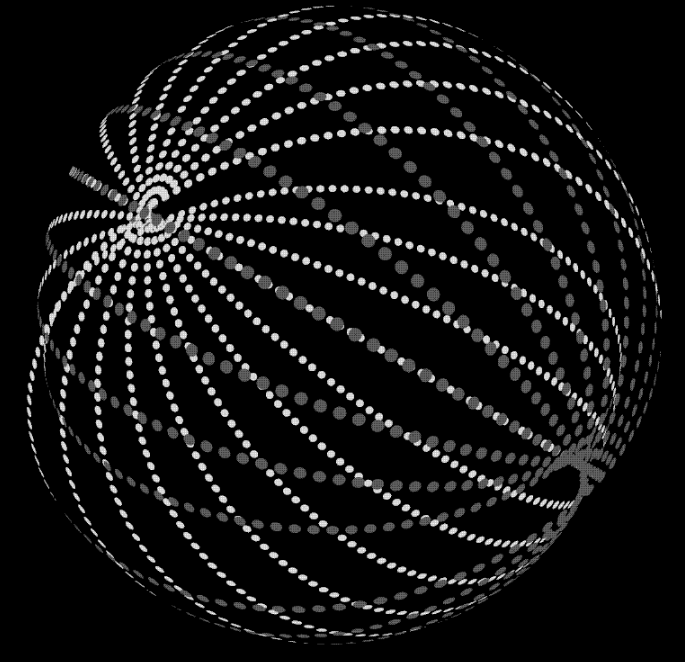
5.9. An Artificial Megastructure
Some astronomers have speculated that the objects eclipsing KIC 8462852 could be parts of a megastructure made by an alien civilization, such as a Dyson swarm,[3][22][34][55] a hypothetical structure that an advanced civilization might build around a star to intercept some of its light for their energy needs.[68][69][70] According to Steinn Sigurðsson, the megastructure hypothesis is implausible and disfavored by Occam's razor and fails to sufficiently explain the dimming. He says that it remains a valid subject for scientific investigation, however, because it is a falsifiable hypothesis.[66] Due to extensive media coverage on this matter, KIC 8462852 has been compared by Kepler's Steve Howell to KIC 4150611,[71] another star with an odd light curve that was shown, after years of research, to be a part of a five-star system.[72] The likelihood of extraterrestrial intelligence being the cause of the dimming is very low;[44] however, the star remains an outstanding SETI target because natural explanations have yet to fully explain the dimming phenomenon.[3][34] Latest results ruled out explanations involving only opaque objects such as stars, planets, swarms of asteroids, or alien megastructures. [73]
6. Follow-Up Studies
Numerous optical telescopes continually monitor KIC 8462852 in anticipation of another multi-day dimming event, with planned follow-up observations of a dimming event using large telescopes equipped with spectrographs to determine if the eclipsing mass is a solid object, or composed of dust or gas.[74] Additional follow-up observations may involve the ground-based Green Bank Telescope, the Very Large Array Radio Telescope,[30][75] and future orbital telescopes dedicated to exoplanetology such as WFIRST, TESS, and PLATO.[34][70]
A Kickstarter fund-raising campaign was led by Tabetha Boyajian, the lead author of the initial study on KIC 8462852's anomalous light curve. The project proposes to use the Las Cumbres Observatory Global Telescope Network for continuous monitoring of the star. The campaign raised over US$100,000, enough for one year of telescope time.[76] Furthermore, more than fifty amateur astronomers working under the aegis of the American Association of Variable Star Observers have been providing effectively full coverage since AAVSO's alert about the star in October 2015,[77] namely a nearly continuous photometric record.[78] In a study published in January 2018, Boyajian et al. reported that whatever is blocking KIC 8462852 filters different wavelengths of light differently, so it cannot be an opaque object. They concluded that it is most likely space dust.[41][42][79]
6.1. SETI Results
In October 2015, the SETI Institute used the Allen Telescope Array to look for radio emissions from possible intelligent extraterrestrial life in the vicinity of the star.[80][81] After an initial two-week survey, the SETI Institute reported that it found no evidence of technology-related radio signals from the star system.[82][83][84] No narrowband radio signals were found at a level of 180–300 Jy in a 1 Hz channel, or medium-band signals above 10 Jy in a 100 kHz channel.[83]
In 2016, the VERITAS gamma-ray observatory was used to search for ultra-fast optical transients from astronomical objects, with astronomers developing an efficient method sensitive to nanosecond pulses with fluxes as low as about one photon per square meter. This technique was applied on archival observations of KIC 8462852 from 2009 to 2015, but no emissions were detected.[85][86]
In May 2017, a related search, based on laser light emissions, was reported, with no evidence found for technology-related signals from KIC 8462852.[87][88]
In September 2017, some SETI@Home workunits were created based on a previous RF survey of the region around this star.[89] This was coupled with a doubling in the size of SETI@Home workunits, so the workunits related to this region will probably be the first workunits to have less issues with quantization noise.
6.2. EPIC 204278916
A star called EPIC 204278916, as well as some other young stellar objects, have been observed to exhibit dips similar to those observed in KIC 8462852. They differ in several aspects, however. EPIC 204278916 shows much deeper dips than KIC 8462852, and they are grouped over a shorter period, whereas the dips at KIC 8462852 are spread out over several years. Furthermore, EPIC 204278916 is surrounded by a proto-stellar disc, whereas KIC 8462852 appears to be a normal F-type star displaying no evidence of a disc.[90]
7. 2017 Light Fluctuations
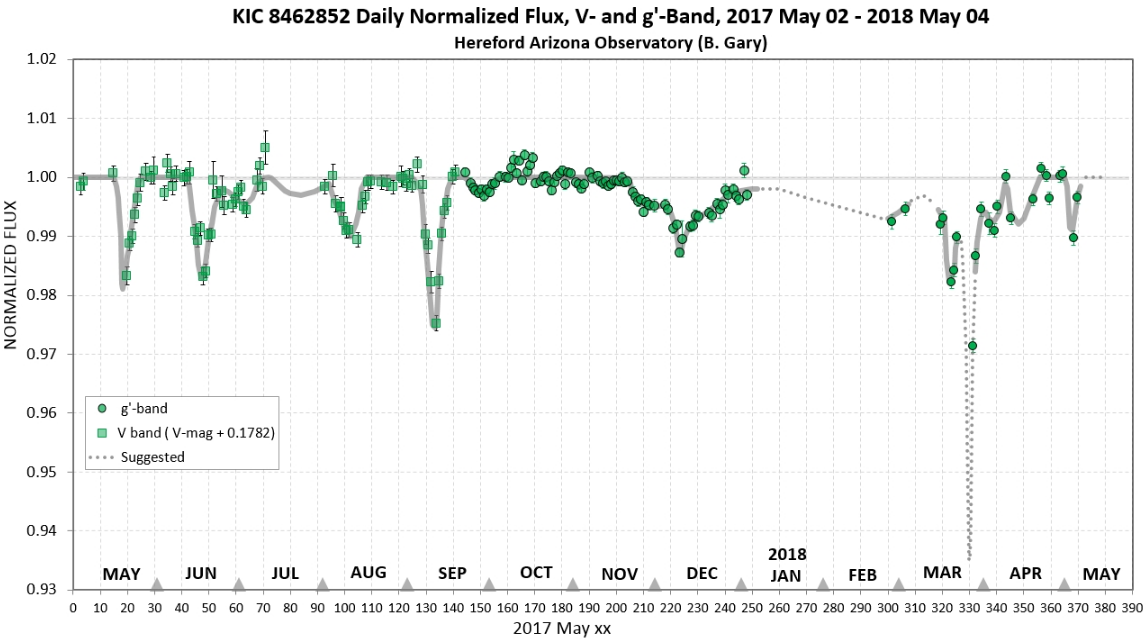
On 20 May 2017, Boyajian and her colleagues reported, via The Astronomer's Telegram, on an ongoing dimming event (named "Elsie"[42][91]) which possibly began on 14 May 2017.[92] It was detected by the Las Cumbres Observatory Global Telescope Network, specifically by its telescope located in Maui (LCO Maui). This was verified by the Fairborn Observatory (part of the N2K Consortium) in Southern Arizona (and later by LCO Canary Islands).[93][94][95] Further optical and infrared spectroscopy and photometry were urgently requested, given the short duration, measured in days or weeks, of these events.[92] Observations from multiple observers globally were coordinated, including polarimetry.[96] Furthermore, the independent SETI projects Breakthrough Listen and Near-InfraRed Optical SETI (NIROSETI), both at Lick Observatory, continue to monitor the star.[92][97][98][99] By the end of the three-day dimming event,[100] a dozen observatories had taken spectra, with some astronomers having dropped their own projects to provide telescope time and resources. More generally the astronomical community was described as having gone "mildly bananas" over the opportunity to collect data in real-time on the unique star.[101] The 2% dip event was named "Elsie" (in reference to Las Cumbres and light curve).[102]
Initial spectra with FRODOSpec at the two-meter Liverpool Telescope showed no changes visible between a reference spectrum and this dip.[97][98][99] Several observatories, however, including the twin Keck telescopes (HIRES) and numerous citizen science observatories, acquired spectra of the star,[92][98][99] showing a dimming dip that had a complex shape, and initially had a pattern similar to the one at 759.75 days from the Kepler event 2, epoch 2 data. Observations were taken across the electromagnetic spectrum.
Evidence of a second dimming event (named "Celeste"[91]) was observed on 13–14 June 2017, and which possibly began 11 June, by amateur astronomer Bruce L. Gary.[103] While the light curve on 14 and 15 June indicated a possible recovery from the dimming event, the dimming continued to increase afterwards,[103] and on 16 June, Boyajian wrote that the event was approaching a 2% dip in brightness.[42][104]
A third prominent 1% dimming event (named "Skara Brae"[91]) was detected beginning 2 August 2017,[105][106] and which recovered by 17 August.[42][107]
A fourth prominent dimming event (named "Angkor"[91]) began 5 September 2017,[108] and is, as of 16 September 2017, between 2.3%[109] and 3%[110] dimming event, making it the "deepest dip this year".[42][111]
Another dimming event, amounting to a 0.3% dip, began around 21 September 2017 and completely recovered by 4 October 2017.
On 10 October 2017, an increasing brightening, lasting about two weeks, of the starlight from KIC 8462852 was noted by Bruce L. Gary of the Hereford Arizona Observatory[45] and Boyajian.[112] A possible explanation, involving a transiting "brown dwarf" in a 1600-day eccentric orbit near KIC 8462852, a "drop feature" in dimness and predicted intervals of "brightening", to account for the unusual fluctuating starlight events of KIC 8462852, has been proposed.[45][46][47]
On 20 November 2017 (est), a fifth prominent dimming event began and had deepened to a 0.44% depth; as of 16 December 2017, the event recovered, leveled off at dip bottom for 11 days, faded again, to a current total dimming depth of 1.25%, and is now recovering again.[45]
Dimming and brightening events of the star continue to be monitored; related light curves are currently updated and released frequently.[49][113]
8. 2018 Light Fluctuations
The star was too close to the Sun's position in the sky from late December, 2017 to mid February, 2018 to be seen. Observations resumed in late February.[49][114] A new series of dips began on 16 March 2018. By 18 March 2018 the star was down by more than 1% in g-band, according to Bruce L. Gary,[49] and about 5% in r-band, making it the deepest dip observed since the Kepler Mission in 2013, according to Tabetha S. Boyajian.[115][116][117] A second even deeper dip with a depth of 5+% started on 24 March 2018, as confirmed by AAVSO observer John Hall.[118][119] As of 27 March 2018, that second dip is recovering.[120]
9. Light Curve Gallery

Rough draft of all known dimmings, from December 2009 to December 2017
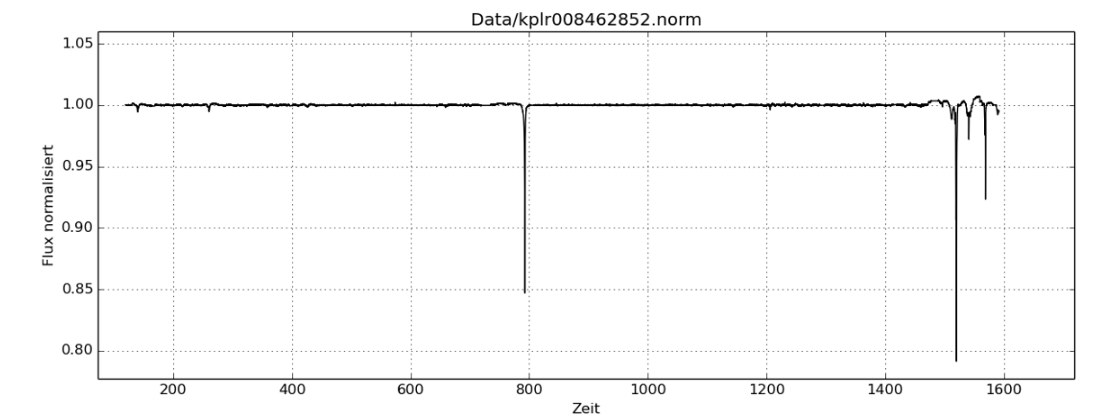
All light curve data − December 2009 to May 2013, scan days 0066 to 1587 (Kepler)
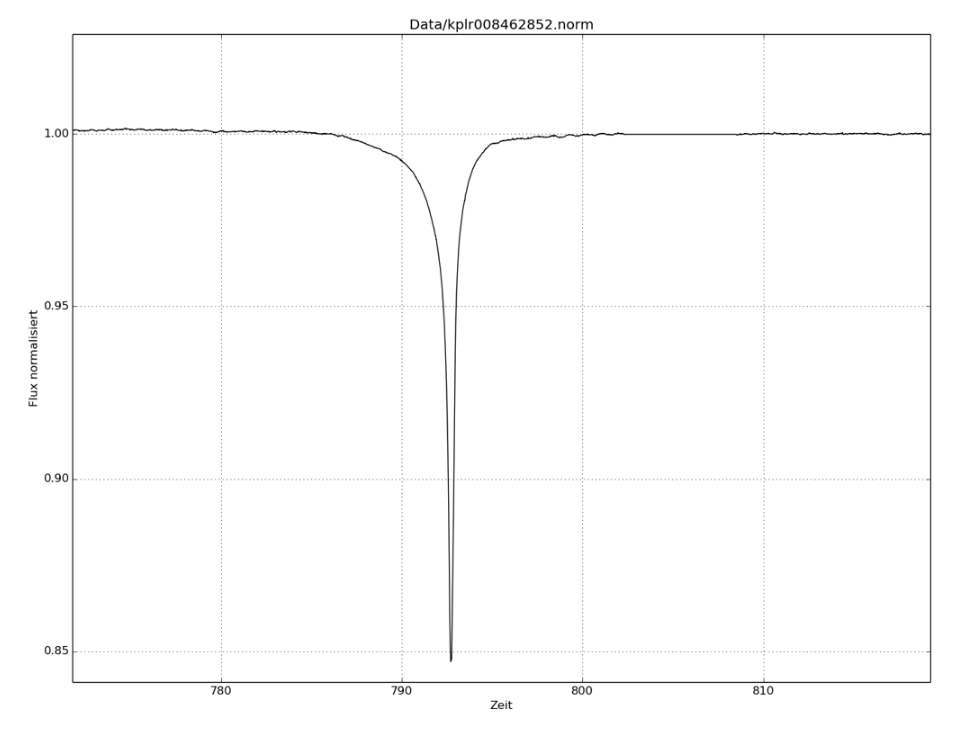
5 March 2011 − day 792
15% max dip (Kepler)
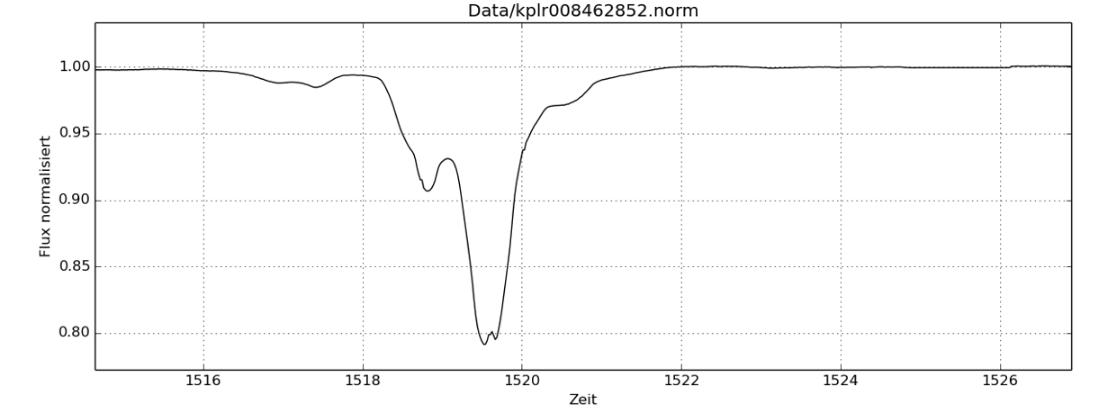
28 February 2013 − day 1519
22% max dip (Kepler)
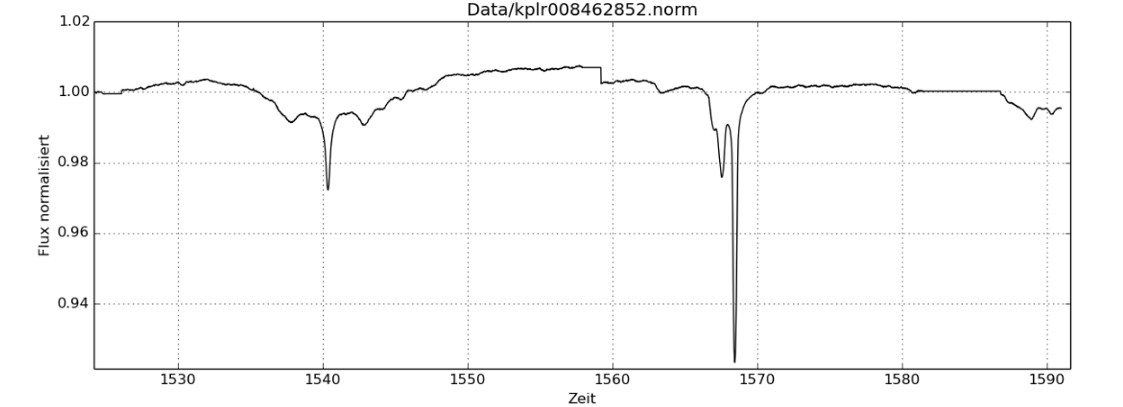
17 April 2013 − day 1568
8% max dip (Kepler)

One year light curve − up to 4 May 2018
(HAO)
The content is sourced from: https://handwiki.org/wiki/Astronomy:KIC_8462852
References
- Wenz, John (9 February 2016). "NASA's Next Great Telescope Will Settle This Alien Megastructure Mystery For Good". Popular Mechanics. http://www.popularmechanics.com/space/telescopes/a19346/james-webb-telescope-alien-megastructure/. Retrieved 13 February 2016.
- Wright, Jason T. (30 August 2016). "What Could Be Going on with Boyajian's Star? Part I". AstroWright. Pennsylvania State University. http://sites.psu.edu/astrowright/2016/08/30/what-could-be-going-on-with-boyajians-star-part-i/. Retrieved 12 September 2016.
- Wright, Jason T. (15 October 2015). "KIC 8462852: Where's the Flux?". AstroWright. Pennsylvania State University. http://sites.psu.edu/astrowright/2015/10/15/kic-8462852wheres-the-flux/. Retrieved 16 October 2015.
- Newsome, John (16 October 2015). "Space anomaly gets extraterrestrial intelligence experts' attention". CNN News. http://www.cnn.com/2015/10/15/world/extraterrestrial-intelligence-anomaly. Retrieved 16 October 2015.
- "Discovery of a strange star could mean alien life". Fox News. 15 October 2015. http://fox43.com/2015/10/15/discovery-of-a-strange-star-could-mean-alien-life. Retrieved 16 October 2015.
- King, Bob (16 October 2015). "What's Orbiting KIC 8462852 – Shattered Comet or Alien Megastructure?". Universe Today. https://www.universetoday.com/122865/whats-orbiting-kic-8462852-shattered-comet-or-alien-megastructure/. Retrieved 16 October 2015.
- Strom, Marcus (15 October 2015). "It's either aliens or a swarm of comets: scientists baffled by WTF 001, our galaxy's strangest star". The Sydney Morning Herald. https://www.smh.com.au/technology/its-either-aliens-or-a-swarm-of-comets-scientists-baffled-by-wtf-001-our-galaxys-strangest-star-20151015-gk9iwj.html. Retrieved 16 October 2015.
- Gary, Bruce L. (3 June 2018). "KIC 8462852 Hereford Arizona Observatory Photometry Observations #6 - Bruce Gary, Last updated: 2018.06.02 20 UT". BruceGary.net. Archived from the original on 3 June 2018. https://web.archive.org/web/20180603125601/http://www.brucegary.net/ts6/. Retrieved 3 June 2018.
- "KIC10 Search Results". Space Telescope Science Institute. https://archive.stsci.edu/kepler/kic10/search.php?kic_kepler_id=8462852&action=Search. Retrieved 16 October 2015.
- Sinnott, Roger W. (2010). Sky & Telescope's Pocket Sky Atlas (3rd ed.). Cambridge, Massachusetts: Sky Publishing. ISBN 978-1-931559-31-7.
- Masi, Gianluca (16 October 2015). "KIC 8462852: A star and its secrets". The Virtual Telescope Project 2.0. http://www.virtualtelescope.eu/2015/10/16/kic-8462852-a-star-and-its-secrets/. Retrieved 22 October 2015.
- Aron, Jacob (15 January 2016). "Comets can't explain weird 'alien megastructure' star after all". New Scientist. https://www.newscientist.com/article/dn28786-comets-cant-explain-weird-alien-megastructure-star-after-all/. Retrieved 16 January 2016.
- Schaefer, Bradley E. (13 January 2016). "KIC 8462852 Faded at an Average Rate of 0.165+-0.013 Magnitudes Per Century From 1890 To 1989". The Astrophysical Journal 822 (2): L34. doi:10.3847/2041-8205/822/2/L34. Bibcode: 2016ApJ...822L..34S. https://dx.doi.org/10.3847%2F2041-8205%2F822%2F2%2FL34
- Hippke, Michael; Angerhausen, Daniel (8 February 2016). "KIC 8462852 did likely not fade during the last 100 years". The Astrophysical Journal 825: 73. doi:10.3847/0004-637X/825/1/73. Bibcode: 2016ApJ...825...73H. https://dx.doi.org/10.3847%2F0004-637X%2F825%2F1%2F73
- "TYC 3162-665-1". SIMBAD. http://simbad.u-strasbg.fr/simbad/sim-id?Ident=TYC%203162-665-1. Retrieved 17 June 2016.
- "Hipparcos". European Space Agency. http://sci.esa.int/hipparcos/. Retrieved 17 June 2016.
- "About 2MASS". California Institute of Technology. http://www.ipac.caltech.edu/2mass/overview/about2mass.html. Retrieved 17 June 2016.
- "USNO CCD Astrograph Catalog (UCAC)". United States Naval Observatory. http://www.usno.navy.mil/USNO/astrometry/optical-IR-prod/ucac. Retrieved 17 June 2016.
- Clavin, Whitney; Harrington, J. D. (14 March 2012). "NASA Releases New WISE Mission Catalog of Entire Infrared Sky". NASA. http://www.nasa.gov/mission_pages/WISE/news/wise20120314.html. Retrieved 17 June 2016.
- "Kepler: FAQ". NASA. http://kepler.nasa.gov/Mission/faq/. Retrieved 17 June 2016.
- Plait, Phil (14 October 2015). "Did Astronomers Find Evidence of an Alien Civilization? (Probably Not. But Still Cool.)". Slate. http://www.slate.com/blogs/bad_astronomy/2015/10/14/weird_star_strange_dips_in_brightness_are_a_bit_baffling.html. Retrieved 15 October 2015.
- Andersen, Ross (13 October 2015). "The Most Mysterious Star in Our Galaxy". The Atlantic. https://www.theatlantic.com/science/archive/2015/10/the-most-interesting-star-in-our-galaxy/410023/. Retrieved 13 October 2015.
- Boyajian, T. S.; LaCourse, D. M.; Rappaport, S. A.; Fabrycky, D.; Fischer, D. A. et al. (April 2016). "Planet Hunters IX. KIC 8462852 – where's the flux?". Monthly Notices of the Royal Astronomical Society 457 (4): 3988–4004. doi:10.1093/mnras/stw218. Bibcode: 2016MNRAS.457.3988B. https://dx.doi.org/10.1093%2Fmnras%2Fstw218
- Aron, Jacob (18 September 2015). "Citizen scientists catch cloud of comets orbiting distant star". New Scientist. https://www.newscientist.com/article/dn28191-citizen-scientists-catch-cloud-of-comets-orbiting-distant-star/. Retrieved 15 October 2015.
- Michael, George (January 2016). "The Great ET Paradox: Why We are Likely to Find Them Before They Find Us". Skeptic 21 (1): 16–18. https://www.skeptic.com/reading_room/the-great-et-paradox/.
- Hippke, Michael; Kroll, Peter; Matthei, Frank; Angerhausen, Daniel; Tuvikene, Taavi; Stassun, Keivan G; Roshchina, Elena; Vasileva, Tatyana et al. (2016). "Sonneberg plate photometry for Boyajian's Star in two passbands". The Astrophysical Journal 837 (837): 85. doi:10.3847/1538-4357/aa615d. Bibcode: 2017ApJ...837...85H. https://dx.doi.org/10.3847%2F1538-4357%2Faa615d
- Montet, Benjamin T.; Simon, Joshua D. (3 August 2016). "KIC 8462852 Faded Throughout the Kepler Mission". The Astrophysical Journal 830 (2): L39. doi:10.3847/2041-8205/830/2/L39. Bibcode: 2016ApJ...830L..39M. https://dx.doi.org/10.3847%2F2041-8205%2F830%2F2%2FL39
- Sacco, Gary et al. (June 2018). "A 1,574-Day Periodicity of Transits Orbiting KIC 8462852". The Journal of the American Association of Variable Star Observers 46 (1): 14. Bibcode: 2018JAVSO..46...14S. https://www.aavso.org/apps/jaavso/article/3327/.
- Powell, Corey S.; Wright, Jason T. (30 June 2017). "The Strangest (and Second-Strangest) Star in the Galaxy". Discover. http://blogs.discovermagazine.com/outthere/2017/06/30/wright/. Retrieved 10 September 2017.
- Rzetelny, Xaq (16 October 2015). "Something—we're not sure what—is radically dimming a star's light". Ars Technica. https://arstechnica.com/science/2015/10/something-were-not-sure-what-is-radically-dimming-a-stars-light. Retrieved 17 October 2015.
- Siegel, Ethan (16 October 2015). "No, Astronomers Probably Haven't Found 'Alien Megastructures'". Forbes. https://www.forbes.com/sites/ethansiegel/2015/10/16/bizarre-star-kic-8462852-an-alien-paradise-or-a-catastrophic-wasteland/. Retrieved 17 October 2015.
- Clavin, Whitney; Johnson, Michele (24 November 2015). "Strange Star Likely Swarmed by Comets". NASA. http://www.nasa.gov/feature/jpl/strange-star-likely-swarmed-by-comets. Retrieved 24 November 2015.
- Lisse, Carey; Sitko, Michael; Marengo, Massimo (December 2015). "IRTF/SPeX Observations of the Unusual Kepler Light Curve System KIC8462852". The Astrophysical Journal Letters 815 (2): L27. doi:10.1088/2041-8205/815/2/L27. Bibcode: 2015ApJ...815L..27L. https://dx.doi.org/10.1088%2F2041-8205%2F815%2F2%2FL27
- Wright, Jason T.; Cartier, Kimberly M. S.; Zhao, Ming; Jontof-Hutter, Daniel; Ford, Eric B. (January 2016). "The Ĝ Search for Extraterrestrial Civilizations with Large Energy Supplies. IV. The Signatures and Information Content of Transiting Megastructures". The Astrophysical Journal 816 (1): 17. doi:10.3847/0004-637X/816/1/17. Bibcode: 2016ApJ...816...17W. https://dx.doi.org/10.3847%2F0004-637X%2F816%2F1%2F17
- null
- Foukal, Peter (June 2017). "An Explanation of the Missing Flux from Boyajian's Mysterious Star". The Astrophysical Journal Letters 842 (1): L3. doi:10.3847/2041-8213/aa740f. Bibcode: 2017ApJ...842L...3F. https://dx.doi.org/10.3847%2F2041-8213%2Faa740f
- Landau, Elizabeth (4 October 2017). "Mysterious Dimming of Tabby's Star May Be Caused by Dust". NASA. https://www.jpl.nasa.gov/news/news.php?feature=6963. Retrieved 4 October 2017.
- Meng, Huan Y. A. et al. (October 2017). "Extinction and the Dimming of KIC 8462852". The Astrophysical Journal 847 (2): 131. doi:10.3847/1538-4357/aa899c. Bibcode: 2017ApJ...847..131M. https://dx.doi.org/10.3847%2F1538-4357%2Faa899c
- Tabor, Abby (4 October 2017). "The Scientific Quest to Explain Kepler's Most Enigmatic Find". NASA. https://www.nasa.gov/feature/ames/the-scientific-quest-to-explain-kepler-s-most-enigmatic-find. Retrieved 5 October 2017.
- Patel, Neel V. (8 September 2017). "We Finally Have Proof the Alien Megastructures Star is Not Aliens". Inverse. https://www.inverse.com/article/36239-tabby-s-star-not-alien-megastructures-new-study-kic-8462852-nasa. Retrieved 10 September 2017.
- Drake, Nadia (3 January 2018). "Mystery of 'Alien Megastructure' Star Has Been Cracked". National Geographic. https://news.nationalgeographic.com/2018/01/mystery-of--alien-megastructure--star-has-been-cracked/. Retrieved 4 January 2018.
- Boyajian, Tabetha S. (2018). "The First Post-Kepler Brightness Dips of KIC 8462852". The Astrophysical Journal 853: L8. doi:10.3847/2041-8213/aaa405. Bibcode: 2018ApJ...853L...8B. https://dx.doi.org/10.3847%2F2041-8213%2Faaa405
- Boyajian, Tabetha S. (4 October 2017). "Dip update 98/n". WheresTheFlux.com. http://www.wherestheflux.com/single-post/2017/10/04/Dip-update-98n. Retrieved 4 October 2017.
- Overbye, Dennis (10 January 2018). "Magnetic Secrets of Mysterious Radio Bursts in a Faraway Galaxy". The New York Times. https://www.nytimes.com/2018/01/10/science/neutron-star-fast-radio-bursts.html. Retrieved 11 January 2018.
- Gary, Bruce L. (16 December 2017). "KIC8462852 Hereford Arizona Observatory Photometry Observations #5". BruceGary.net. Archived from the original on 16 December 2017. https://web.archive.org/web/20171216160904/http://www.brucegary.net/ts5/. Retrieved 16 December 2017.
- Gary, Bruce L.; Bourne, Rafik (11 November 2017). "KIC 8462852 Brightness Pattern Repeating Every 1600 Days". arXiv:1711.04205 [astro-ph.EP]. //arxiv.org/archive/astro-ph.EP
- Bourne, R.; Gary, B. L.; Plakhov, A. (2018). "Recent Photometric Monitoring of KIC 8462852, the Detection of a Potential Repeat of the Kepler Day 1540 Dip and a Plausible Model". Monthly Notices of the Royal Astronomical Society 475 (4): 5378–5384. doi:10.1093/mnras/sty097. Bibcode: 2018MNRAS.475.5378B. https://dx.doi.org/10.1093%2Fmnras%2Fsty097
- Bourne, Rafik; Gary, Bruce L. (20 November 2017). "KIC 8462852: Potential repeat of the Kepler day 1540 dip in August 2017". arXiv:1711.07472 [astro-ph.EP]. //arxiv.org/archive/astro-ph.EP
- Gary, Bruce L. (25 February 2018). "KIC 8462852 Hereford Arizona Observatory Photometry Observations #6". http://www.brucegary.net/ts6/. Retrieved 20 March 2018.
- Redd, Nola Taylor (8 June 2018). "High School Students Help Unravel Mystery of Weirdly Dimming 'Tabby's Star'". Space.com. https://www.space.com/40836-tabbys-star-mystery-dimming-student-discovery.html. Retrieved 8 June 2018.
- Rappaport, S. et al. (2018). "WD 1145+017: Optical Activity During 2016-2017 and Limits on the X-Ray Flux". Monthly Notices of the Royal Astronomical Society 474: 933–946. doi:10.1093/mnras/stx2663. Bibcode: 2018MNRAS.474..933R. https://dx.doi.org/10.1093%2Fmnras%2Fstx2663
- Punzi, K. M. et al. (January 2018). "Is the Young Star RZ Piscium Consuming Its Own (Planetary) Offspring?". The Astronomical Journal 155 (1): 33. doi:10.3847/1538-3881/aa9524. Bibcode: 2018AJ....155...33P. https://dx.doi.org/10.3847%2F1538-3881%2Faa9524
- Reddy, Francis; Garner, Rob (21 December 2017). "New Study Finds 'Winking' Star May Be Devouring Wrecked Planets". NASA. https://www.nasa.gov/feature/goddard/2017/new-study-finds-winking-star-may-be-devouring-wrecked-planets. Retrieved 22 December 2017.
- Bodman, Eva H. L.; Quillen, Alice (27 November 2015). "KIC 8462852: Transit of a Large Comet Family". The Astrophysical Journal 819 (2): L34. doi:10.3847/2041-8205/819/2/L34. Bibcode: 2016ApJ...819L..34B. https://dx.doi.org/10.3847%2F2041-8205%2F819%2F2%2FL34
- Fecht, Sarah (13 October 2015). "Have We Detected Megastructures Built By Aliens Around A Distant Star? Or Just A Cloud Of Comets? Scientists Want To Investigate Further". Popular Science. http://www.popsci.com/have-we-detected-alien-megastructures-around-distant-star. Retrieved 14 October 2015.
- Thompson, M. A.; Scicluna, P.; Kemper, F.; Geach, J. E.; Dunham, M. M. et al. (May 2016). "Constraints on the circumstellar dust around KIC 8462852". Monthly Notices of the Royal Astronomical Society: Letters 458 (1): L39–L43. doi:10.1093/mnrasl/slw008. Bibcode: 2016MNRAS.458L..39T. https://dx.doi.org/10.1093%2Fmnrasl%2Fslw008
- Laker, Chris (16 October 2015). "'Alien megastructure' may explain light patterns from 'bizarre' star, say scientists". BT.com. http://home.bt.com/news/science-news/alien-megastructure-may-explain-light-patterns-from-bizarre-star-say-scientists-11364010755958. Retrieved 17 October 2015.
- Marengo, Massimo; Hulsebus, Alan; Willis, Sarah (November 2015). "KIC 8462852: The Infrared Flux". The Astrophysical Journal Letters 814 (1): L15. doi:10.1088/2041-8205/814/1/L15. Bibcode: 2015ApJ...814L..15M. https://dx.doi.org/10.1088%2F2041-8205%2F814%2F1%2FL15
- Metzger, Brian D.; Shen, Ken J.; Stone, Nicholas C. (December 2016). "Secular Dimming of KIC 8462852 Following its Consumption of a Planet". Monthly Notices of the Royal Astronomical Society 468 (4): 4399–4407. doi:10.1093/mnras/stx823. Bibcode: 2017MNRAS.468.4399M. https://dx.doi.org/10.1093%2Fmnras%2Fstx823
- O'Callaghan, Jonathan (11 January 2017). "The Alien Megastructure Star May Have Eaten A Planet". IFL Science. https://www.iflscience.com/space/alien-megastructure-star-eaten-a-planet/.
- Sucerquia, Mario (2017). "Anomalous lightcurves of young tilted exorings". Monthly Notices of the Royal Astronomical Society: Letters 472 (1): L120–L124. doi:10.1093/mnrasl/slx151. Bibcode: 2017MNRAS.472L.120S. https://dx.doi.org/10.1093%2Fmnrasl%2Fslx151
- Shostak, Seth (1 September 2017). "Has Tabby's Star Mystery Finally Been Solved? From alien megastructures to super-Saturns, all sorts of explanations have been offered for star's weird behavior. Here's where we stand now.". NBCNews. https://www.nbcnews.com/mach/science/tabby-s-star-mystery-still-hasn-t-been-solved-ncna797741. Retrieved 3 September 2017.
- Ballesteros, Fernando J.; Arnalte-Mur, Pablo; Fernandez-Soto, Alberto; Martinez, Vicent J. (2018). "KIC 8462852: Will the Trojans return in 2021?". Monthly Notices of the Royal Astronomical Society: Letters 473: L21–L25. doi:10.1093/mnrasl/slx105. Bibcode: 2018MNRAS.473L..21B. https://dx.doi.org/10.1093%2Fmnrasl%2Fslx105
- "Orbital Diagram Hypothesis of KIC 8462852" (JPG). Twitter. https://pbs.twimg.com/media/DAjVXoeW0AEYZJn.jpg. Retrieved 28 May 2017.
- Foukal, Peter (15 December 2017). "Reddened dimmimg of Boyajian's star supports internal storage of its "missing" flux". Res Notes AAS 1 (1): 52. doi:10.3847/2515-5172/aaa130. Bibcode: 2017RNAAS...1a..52F. https://dx.doi.org/10.3847%2F2515-5172%2Faaa130
- Sigurðsson, Steinn (19 December 2016). "New Clues as to Why Boyajian's Star is Dimming". Physics 9: 150. doi:10.1103/Physics.9.150. Bibcode: 2016PhyOJ...9..150S. https://dx.doi.org/10.1103%2FPhysics.9.150
- Sheikh, Mohammed A.; Weaver, Richard L.; Dahmen, Karin A. (19 December 2016). "Avalanche Statistics Identify Intrinsic Stellar Processes near Criticality in KIC 8462852". Physical Review Letters 117 (26): 261101. doi:10.1103/PhysRevLett.117.261101. PMID 28059527. Bibcode: 2016PhRvL.117z1101S. https://dx.doi.org/10.1103%2FPhysRevLett.117.261101
- Jones, Morris (November–December 2015). "Reconsidering macro-artefacts in SETI searches". Acta Astronautica 116: 161–165. doi:10.1016/j.actaastro.2015.07.011. https://dx.doi.org/10.1016%2Fj.actaastro.2015.07.011
- O'Neill, Ian (14 October 2015). "Has Kepler Discovered an Alien Megastructure?". Discovery.com. http://news.discovery.com/space/alien-life-exoplanets/has-kepler-discovered-an-alien-megastructure-151014.htm. Retrieved 17 October 2015.
- Siemion, Andrew (29 September 2015). "Prepared Statement by Andrew Siemion – Hearing on Astrobiology". House Committee on Science, Space, and Technology. SpaceRef.com. http://www.spaceref.com/news/viewsr.html?pid=47887. Retrieved 19 October 2015.
- Kramer, Miriam (18 October 2015). "Scientists have not actually found an alien megastructure orbiting a distant star". Mashable. https://mashable.com/2015/10/18/alien-megastructure-kepler. Retrieved 27 October 2016.
- Gregg, Trevor A.; Prsa, A.; Welsh, W. F.; Orosz, J. A.; Fetherolf, T. (January 2013). "A Syzygy of KIC 4150611". 221st Meeting of the American Astronomical Society. 6–10 January 2013. Long Beach, California.. 142.12. Bibcode: 2013AAS...22114212G. http://adsabs.harvard.edu/abs/2013AAS...22114212G
- https://arxiv.org/pdf/1809.00693.pdf A Reassessment of Families of Solutions to the Puzzle of Boyajian’s Star
- Wall, Mike (28 October 2015). "'Alien Megastructure' Mystery May Soon Be Solved". Space.com. http://www.space.com/30948-dimming-star-alien-megastructure-mystery.html. Retrieved 28 October 2015.
- Mack, Eric (17 October 2015). "The story behind 'alien megastructures' scientists may have found (but probably didn't)". CNET. http://www.cnet.com/news/the-full-story-behind-the-alien-megastructures-scientists-may-have-found-but-probably-didnt/. Retrieved 19 October 2015.
- Fecht, Sarah (16 June 2016). "'Alien Megastructure' Star Kickstarter Just Met Its Goal". Popular Science. http://www.popsci.com/alien-megastructure-star-just-met-its-kickstarter-goal. Retrieved 16 June 2016.
- null
- "Subreddit FAQ". https://docs.google.com/document/d/1pm4lszHnawepEagciKfPKzgRHscTrOi699EYMpqMe2Q/edit.
- Deeg, H. J.; Alonso, R.; Nespral, D.; Boyajian, Tabetha (2018). "Non-grey dimming events of KIC 8462852 from GTC spectrophotometry". Astronomy & Astrophysics 610 (12): L12. doi:10.1051/0004-6361/201732453. Bibcode: 2018A&A...610L..12D. https://dx.doi.org/10.1051%2F0004-6361%2F201732453
- Wall, Mike (19 October 2015). "Search For Intelligent Aliens Near Bizarre Dimming Star Has Begun". Space.com. http://www.space.com/30855-alien-life-search-kepler-megastructure.html. Retrieved 20 October 2015.
- Orwig, Jessica (23 October 2015). "Scientists are days from finding out if that mysterious star could actually harbor aliens". Business Insider. http://www.businessinsider.com/search-for-aliens-at-kic-8462852-2015-10.
- "Looking for Deliberate Radio Signals from KIC 8462852" (Press release). The SETI Institute. 5 November 2015. Archived from the original on 7 November 2015. Retrieved 8 November 2015. Unknown parameter |dead-url= ignored (|url-status= suggested) (help) https://web.archive.org/web/20151107233307/http://www.seti.org/seti-institute/press-release/looking-deliberate-radio-signals-kic-8462852
- Harp, G. R.; Richards, Jon; Shostak, Seth; Tarter, J. C.; Vakoch, Douglas A. et al. (July 2016). "Radio SETI Observations of the Anomalous Star KIC 8462852". The Astrophysical Journal 825 (2): 155. doi:10.3847/0004-637X/825/2/155. Bibcode: 2016ApJ...825..155H. https://dx.doi.org/10.3847%2F0004-637X%2F825%2F2%2F155
- Schuetz, Marlin; Vakoch, Douglas A.; Shostak, Seth; Richards, Jon (July 2016). "Optical SETI Observations of the Anomalous Star KIC 8462852". The Astrophysical Journal Letters 825 (1): L5. doi:10.3847/2041-8205/825/1/L5. Bibcode: 2016ApJ...825L...5S. https://dx.doi.org/10.3847%2F2041-8205%2F825%2F1%2FL5
- Abeysekara, A. U. et al. (February 2016). "A Search for Brief Optical Flashes Associated with the SETI Target KIC 8462852". The Astrophysical Journal Letters 818 (2): L33. doi:10.3847/2041-8205/818/2/L33. Bibcode: 2016ApJ...818L..33A. https://dx.doi.org/10.3847%2F2041-8205%2F818%2F2%2FL33
- Holder, Jamie (9 September 2016). "Latest Results from VERITAS: Gamma 2016". AIP Conference Proceedings 1792 (1): 020013. doi:10.1063/1.4968898. Bibcode: 2017AIPC.1792b0013H. https://dx.doi.org/10.1063%2F1.4968898
- Koren, Marina (17 April 2017). "Searching the Skies for Alien Laser Beams". The Atlantic. https://www.theatlantic.com/science/archive/2017/04/laser-seti-extraterrestrial/523104/. Retrieved 3 June 2017.
- Tellis, Nathaniel K.; Marcy, Geoffrey W. (8 April 2017). "A Search for Laser Emission with Megawatt Thresholds from 5600 FGKM Stars". The Astronomical Journal 153 (6): 251. doi:10.3847/1538-3881/aa6d12. Bibcode: 2017AJ....153..251T. https://dx.doi.org/10.3847%2F1538-3881%2Faa6d12
- Korpela, Eric (7 September 2017). "Data from "Tabby's Star" is flowing". University of California, Berkeley. https://setiathome.berkeley.edu/forum_thread.php?id=81903&postid=1888412#1888412. Retrieved 12 September 2017.
- Scaringi, S.; Manara, C. F.; Barenfeld, S. A.; Groot, P. J.; Isella, A. et al. (December 2016). "The peculiar dipping events in the disk-bearing young-stellar object EPIC 204278916". Monthly Notices of the Royal Astronomical Society 463 (2): 2265–2272. doi:10.1093/mnras/stw2155. Bibcode: 2016MNRAS.463.2265S. https://dx.doi.org/10.1093%2Fmnras%2Fstw2155
- Boyajian, Tabetha S. (18 September 2017). "Dip update 85/n - Welcome Angkor!". WheresTheFlux.com. http://www.wherestheflux.com/single-post/2017/09/18/Dip-update-85n---Welcome-Angkor. Retrieved 18 September 2017.
- Boyajian, Tabetha S.; Croft, Steve; Wright, Jason T. (20 May 2017). "A Drop in Optical Flux from Boyajian's Star". The Astronomer's Telegram. http://www.astronomerstelegram.org/?read=10405. Retrieved 21 May 2017.
- Koren, Marina (19 May 2017). "The 'Alien Megastructure' Star Is Dimming Again". The Atlantic. https://www.theatlantic.com/science/archive/2017/05/tabbys-star-alien-megastructure/527382/. Retrieved 23 May 2017.
- Arboleda, Lawrence (20 May 2017). "That 'Alien Megastructure' Star Has Gone Haywire Again And Scientists Are Baffled". http://www.inquisitr.com/4231231/alien-megastructure-star-dyson-sphere-tabbys-star-spectra/.
- Clery, Daniel (22 May 2017). "Star that spurred alien megastructure theories dims again". Science. http://www.sciencemag.org/news/2017/05/star-spurred-alien-megastructure-theories-dims-again. Retrieved 25 May 2017.
- Ellis, Tyler (19 May 2017). "WTF Has Gone Into a Dip!". http://www.wherestheflux.com/single-post/2017/05/19/WTF-Has-Gone-Into-a-Dip.
- Steele, Iain et al. (20 May 2017). "Medium Resolution Spectroscopy of Boyajian's Star (KIC 8462852)". The Astronomer's Telegram. http://www.astronomerstelegram.org/?read=10406. Retrieved 21 May 2017.
- Wright, Jason T. (19 May 2017). "Tabby's Star is dimming right now (archived video of chat with Jason T. Wright)". YouTube. https://www.youtube.com/watch?v=eYpIGZS8nJc&feature=youtu.be&t=52s. Retrieved 21 May 2017.
- Staff (20 May 2017). "Mysterious Tabby's Star dims again: observations needed". The Lined Wolf. https://angelrls.wordpress.com/2017/05/20/mysterious-tabbys-star-dims-again-observations-needed. Retrieved 21 May 2017.
- Cooper, Keith (24 May 2017). "The Galaxy's strangest star dims again". Astronomy Now. https://astronomynow.com/2017/05/24/the-galaxys-strangest-star-dims-again/. Retrieved 25 May 2017.
- Kaplan, Sarah (24 May 2017). "The weirdest star in the sky is acting up again". https://www.washingtonpost.com/news/speaking-of-science/wp/2017/05/24/the-weirdest-star-in-the-sky-is-acting-up-again/.
- null
- Gary, Bruce L. (21 June 2017). "Kepler Star KIC 8462852 Amateur Photometry Monitoring Project". Archived from the original on 21 June 2017. https://web.archive.org/web/20170621221807/http://www.brucegary.net/ts/.
- Boyajian, Tabetha S. [@tsboyajian] (16 June 2017). "#TabbysStar is approaching 2% dim - Who Will Observe Tonight?!!". https://twitter.com/tsboyajian/status/875839712682020864.
- Boyajian, Tabetha S. (2 August 2017). "Dip update 47/n". Where's the Flux?. http://www.wherestheflux.com/single-post/2017/08/02/Dip-update-47n. Retrieved 11 August 2017.
- Boyajian, Tabetha S. (10 August 2017). "Dip update 54/n". Where's the Flux?. http://www.wherestheflux.com/single-post/2017/08/10/Dip-update-54n. Retrieved 11 August 2017.
- Gary, Bruce L. (18 August 2017). "Hereford Arizona Observatory photometry observations of KIC 8462852 between 2 May and 17 August 2017.". BruceGary.net. Archived from the original on 20 August 2017. https://web.archive.org/web/20170820231346/http://www.brucegary.net/ts/. Retrieved 20 August 2017.
- Gary, Bruce L. (8 September 2017). "Hereford Arizona Observatory photometry observations of KIC 8462852 between 2 May and 8 September 2017.". BruceGary.net. Archived from the original on 8 September 2017. https://web.archive.org/web/20170908212152/http://www.brucegary.net/ts/. Retrieved 8 September 2017.
- Gary, Bruce L. (16 September 2017). "Hereford Arizona Observatory photometry observations of KIC 8462852 between 2 May and 16 September 2017". BruceGary.net. Archived from the original on 17 September 2017. https://web.archive.org/web/20170917125504/http://www.brucegary.net/ts3/. Retrieved 17 September 2017.
- Boyajian, Tabetha S. (10 September 2017). "Tweets: "Now @tsboyajian's star is down 3%! How low will it go? Hi-res spectra and IR photometry needed!" - Jason T. Wright". Twitter. Archived from the original on 17 September 2017. https://web.archive.org/web/20170917125736/https://twitter.com/tsboyajian/status/906898237398962176. Retrieved 17 September 2017.
- Gary, Bruce L. (10 September 2017). "Hereford Arizona Observatory photometry observations of KIC 8462852 between 2 May and 10 September 2017.". BruceGary.net. Archived from the original on 10 September 2017. https://web.archive.org/web/20170910071659/http://www.brucegary.net/ts3/. Retrieved 10 September 2017.
- Boyajian, Tabetha S. (6 November 2017). "Dip update 111/n". WheresTheFlux.com. http://www.wherestheflux.com/single-post/2017/11/06/Dip-update-111n. Retrieved 7 November 2017.
- Gary, Bruce L. (14 November 2017). "Hereford Arizona Observatory photometry observations of KIC 8462852". BruceGary.net. http://www.brucegary.net/ts5/. Retrieved 17 December 2017.
- Boyajian, Tabetha S. (8 March 2018). "Dip update 130/n - The 2018 observing campaign begins!". WheresTheFlux.com. http://www.wherestheflux.com/single-post/2018/03/08/The-2018-observing-season-begins. Retrieved 20 March 2018.
- Boyajian, Tabetha S. (19 March 2018). "tldr: DIPPING!!!". WheresTheFlux.com. http://www.wherestheflux.com/single-post/2018/03/19/tldr-DIPPING. Retrieved 20 March 2018.
- Boyajian, Tabetha S. (26 March 2018). "2018 March: dip update 7/n". WheresTheFlux.com. http://www.wherestheflux.com/single-post/2018/03/26/2018-March-dip-update-7n. Retrieved 27 March 2018.
- Adamson, Allan (27 March 2018). "Alien Megastructure Star: Dimming Of Tabby's Star Sets New Record". TechTimes.com. http://www.techtimes.com/articles/223621/20180327/alien-megastructure-star-dimming-of-tabbys-star-sets-new-record.htm. Retrieved 27 March 2018.
- null
- null
- null

